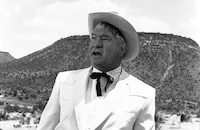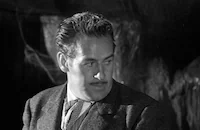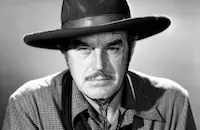Ride the Man Down
Cast & Crew
Joseph Kane
Brian Donlevy
Rod Cameron
Ella Raines
Forrest Tucker
Barbara Britton
Film Details
Technical Specs

Synopsis
When pioneer ranching magnate Phil Evarts perishes in the 1892 blizzard, the Hatchet Ranch goes to his brother John and daughter Celia. Much of the ranch is on free grazing land, so by spring, people are whittling away at the empire by moving in their own cattle. Some are greedy, like rancher Bide Marriner, while others, like rustler Red Courteen, resent the Evartses' power. Ranchers Harve Garrison, Russ Schultz and Ray Cavanaugh covet the Hatchet's rich grazing land and help themselves to it, now that the tough old Evarts is no longer around to protect it. The ranch foreman, Will Ballard, wants to keep the sprawling ranch intact for Celia, whom he admires as "a maverick" like himself, but few people, including sheriff Joe Kneen, support his efforts. Will's girlfriend, Lottie Priest, wants him to give up the fight for Hatchet and instead focus on her, while her avaricious father Lowell, the general store owner, takes Harve as a partner in a cattle deal. Even Celia's fiancé, rancher Sam Danfelser, suggests officially giving Bide the watering hole, Indian Springs, which he has already taken. To discourage the squatters, Will has Ike Adams and the other ranchhands round up and hold all non-Hatchet cattle. When Cavanaugh learns that his cattle have been seized, he shoots John in the back and hides the body. Will searches for John, and after learning that Cavanaugh killed him, fends off an attack by Courteen and his cohorts. When Will tells Celia about Cavanaugh, she gives her approval for him to confront the killer. Seeing how Celia and Will tacitly understand each other, Sam jealously tries to fire Will, and then begins to associate more with Bide. Lottie, too, is jealous of Will's loyalty to Celia, and is angry when her father's cattle are seized. One day, Will and Ike find Mel and Jim Young, who are barely into adulthood, grazing their cattle on Hatchet land. The brothers explain that Courteen told them that Hatchet land was free for the taking, but sheepishly offer to leave. However, Will hires them as ranchhands in exchange for meals and grazing rights, and later after most of the ranchhands quit in fear, Mel and Jim remain loyal. Meanwhile, Bide wants Joe to arrest Cavanaugh, explaining that the killer will plead self-defense, and the trial will be a public defeat for both Will and the ranch. However, Joe's allegiance has changed since John's murder, and when Will demands to duel Cavanaugh and even gives the killer a chance at the first shot, Joe does not interfere, as he knows a fair trial will not happen. After Cavanaugh shoots at Will and then dies in a cowardly escape, Will expresses surprise at Joe's change of heart, but Joe says he wants to be an honest man. Later, Bide learns that Harve and several other ranchers are also refusing to help bring in Will. To spite Will, Courteen and his thugs tear up his office and shoot Ike in the leg, while Celia valiantly fights them. Later Bide and Sam, whose jealousy has become an obsession, set a trap for Will at the ranch, but Celia manages to warn Will and is relieved to break up with Sam. In town, Will and Lottie's romance also ends, and he leaves to hide at the Cavanaugh place. After Celia finds him, Will tells her a plan that might save Hatchet, despite the odds against them. He has Mel and Joe dynamite Indian Springs. In retaliation, Bide and Sam announce that they will move their cattle farther into the Hatchet ranch instead of back to their own, but are surprised when Joe tells them he is alerting the U.S. Marshal. Joe explains that Indian Springs is "open range" for as long as a rancher can keep it, but farther in, Evarts has patented land, and to intrude there is a federal offense. At the telegraph office, Bide tries shooting Joe from behind, but Joe's return fire kills Bide and the telegram is sent. Meanwhile, Lottie betrays Will by warning Courteen of his plans to drive the seized herds off the ranch. With Sam's help, Courteen ambushes Will, but is killed in the shootout. Will, Ike and Mel, who has been shot, escape to Cavanaugh's shack, while Jim acts as decoy, but after a lengthy chase, Sam backtracks to search for Will. That evening, Celia arrives with news about Joe, and again warns Will about Sam's obsession, but Will says he will not avoid Sam. As they talk, they hear Sam ride up for a final showdown, and as Will and Ike prepare for trouble, Celia slips away toward the sound of the rider. When they hear a gunshot, Will fears for Celia, and he and Jim, who followed Sam to the shack, shoot at the rider. In the silence that follows, Celia emerges from the trees, and the relieved Will tells Celia that Hatchet is now safe, because two mavericks beat off the whole country.

Director
Joseph Kane
Cast

Brian Donlevy
Rod Cameron

Ella Raines

Forrest Tucker

Barbara Britton

Chill Wills

J. Carrol Naish

Jim Davis

Taylor Holmes
James Bell

Paul Fix
Al Caudebec
Roydon Clark

Roy Barcroft

Douglas Kennedy
Chris Pin Martin

Jack Larue
Claire Carleton
Harry Cheshire
Stanley Andrews
Pat Flaherty
Francis Mcdonald

Harry Woods
Tex Terry
Walter Brennan Jr.
Marshall Reed
Crew
Fred Allen
Frank Arrigo
Earl Crain Sr.
Ned Freeman
Wilson Grantham
Peggy Gray
John Grubbs
Joseph Kane
Howard Lydecker
Theodore Lydecker
Bob Mark
Jack Marta
Mary Mccall Jr.
John Mccarthy Jr.
Theodore F. Offenbecker
Adele Palmer
Robert Shannon
Luke Short
Howard Wilson
Herbert J. Yates

Film Details
Technical Specs

Quotes
Trivia
Notes
Luke Short's novel was serialized in The Saturday Evening Post (4 April-16 May 1942). A written prologue mentions that in 1880, during President Rutherford B. Hayes's administration, millions of acres became available for great herds of cattle. Although Call Bureau Cast Service includes child actress Sandra Spence in the film, there were no children in the viewed print. Portions of the film were shot on location in Kanab, UT. During production, a storm snowed in the company of ninety, but enabled winter sequence footage to be shot, according to April 1952 Hollywood Reporter news items. A March 1952 Hollywood Reporter news item states that director Joseph Kane, director of photography Jack Marta and unit manager John Grubbs scouted New Mexico locations for this film, but whether actual filming took place there has not been confirmed. Because the last scene on the viewed copy was dark and the dialogue vague, the ending May have varied somewhat from the above summary.












